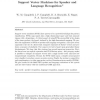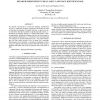255 search results - page 26 / 51 » On the use of speaker superfactors for speaker recognition |
CSL
2006
Springer
13 years 7 months ago
2006
Springer
Support vector machines (SVMs) have proven to be a powerful technique for pattern classification. SVMs map inputs into a high dimensional space and then separate classes with a hy...
TASLP
2008
13 years 7 months ago
2008
The new model reduces the impact of local spectral and temporal variability by estimating a finite set of spectral and temporal warping factors which are applied to speech at the f...
ENGL
2006
13 years 7 months ago
2006
We describe in this paper the use of neural networks, fuzzy logic and genetic algorithms for voice recognition. In particular, we consider the case of speaker recognition by analyz...
LREC
2010
13 years 8 months ago
2010
The SignSpeak project will be the first step to approach sign language recognition and translation at a scientific level already reached in similar research fields such as automat...
ICASSP
2010
IEEE
13 years 7 months ago
2010
IEEE
We describe experiments in visual-only language identification (VLID), in which only lip shape, appearance and motion are used to determine the language of a spoken utterance. In...


